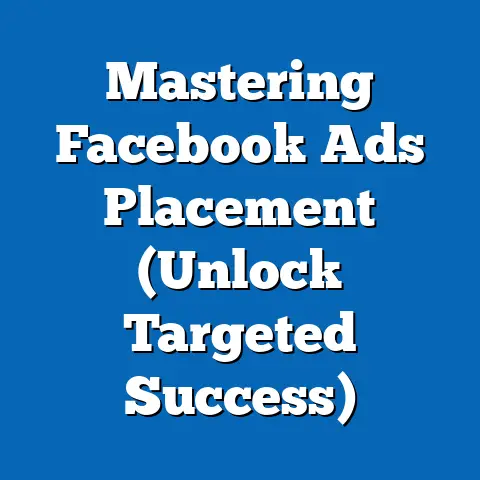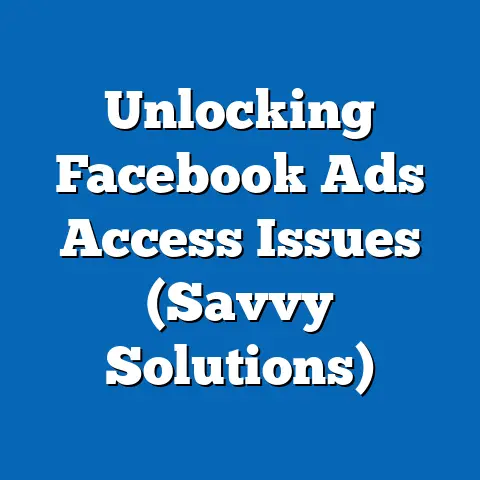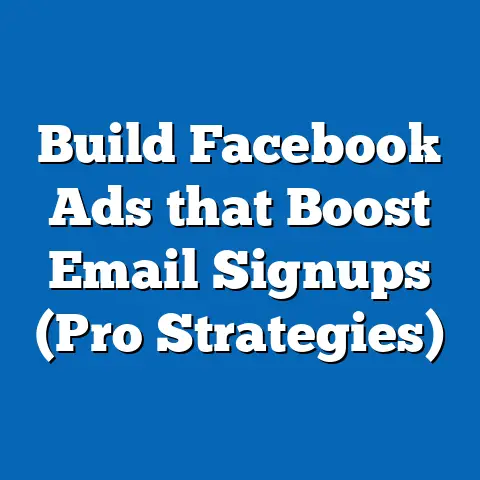Win Lucrative Clients for fb ad Agency (Proven Strategies)
I’m about to dive deep into the world of Facebook Ad Agencies and how to land those high-paying clients that make the business truly rewarding. Forget the grind of chasing low-budget projects; we’re aiming for a roster of clients who value your expertise and understand the transformative power of a well-executed Facebook ad campaign.
Imagine this: you’re not just running ads; you’re crafting digital experiences that fuel growth, build brands, and ultimately, give business owners the freedom to live the lives they’ve always dreamed of. That’s the power of Facebook advertising done right, and that’s the value you, as an agency owner, bring to the table.
The modern entrepreneur isn’t just after revenue; they crave freedom – freedom from the endless hustle, freedom to spend time with family, freedom to pursue their passions. They want financial stability that allows them to invest in their future and scale their business without the constant fear of burnout.
Facebook advertising has become a lifeline for these businesses, especially small to medium-sized enterprises (SMBs) eager to break through the noise and connect with their ideal customers. With its unparalleled targeting capabilities and diverse ad formats, Facebook offers a powerful platform to achieve these aspirations.
But here’s the catch: navigating the complexities of Facebook Ads Manager, crafting compelling ad copy, and optimizing campaigns for maximum ROI can be overwhelming. That’s where your Facebook ad agency comes in. You’re the expert, the guide, the partner who can transform their advertising dreams into reality.
However, the market is competitive. To stand out and attract those lucrative clients, you need more than just technical skills. You need a proven strategy, a deep understanding of your clients’ needs, and a commitment to delivering exceptional results. This article is your roadmap to achieving just that. We’ll explore the essential steps to building a successful Facebook ad agency that attracts clients who value your expertise and contribute to your own success story.
Understanding the Client’s Perspective: Empathy is Your Superpower
Before you even think about crafting the perfect pitch or showcasing your impressive portfolio, you need to step into your potential client’s shoes. What are their biggest challenges? What keeps them up at night? What are their deepest desires for their business?
Most potential clients are facing a similar set of hurdles. They’re battling tight budgets, fierce competition, and the constant pressure to prove ROI. They’ve likely been burned by ineffective advertising campaigns in the past, leaving them skeptical and hesitant to invest further.
I remember one client who came to me after spending thousands on a campaign that yielded virtually no results. They were understandably frustrated and distrustful. It wasn’t until I took the time to truly understand their business, their target audience, and their specific goals that I could earn their trust and develop a strategy that delivered tangible results.
That’s why empathy is your superpower. It’s the ability to connect with your clients on a human level, to understand their pain points, and to position your agency as a trusted partner, not just a service provider.
Here are a few ways to cultivate empathy and gain valuable insights into your potential clients’ perspectives:
- Conduct thorough client interviews: Don’t just ask about their business; ask about their aspirations. What does success look like to them? What are their biggest fears? What are they hoping to achieve through Facebook advertising?
- Send out surveys: Use online survey tools to gather data about their specific needs and expectations. Ask about their current advertising strategies, their past experiences, and their biggest challenges.
- Research their industry: Immerse yourself in their world. Read industry publications, attend conferences, and follow key influencers. This will help you understand the trends, challenges, and opportunities that they face.
- Analyze their competitors: Take a close look at their competitors’ advertising strategies. What are they doing well? What could they be doing better? This will give you valuable insights into the market landscape and help you identify opportunities for your clients.
By understanding your clients’ perspectives, you can tailor your services to meet their specific needs, build stronger relationships, and ultimately, deliver better results. Remember, it’s not just about running ads; it’s about helping your clients achieve their dreams.
Takeaway: Prioritize empathy and understanding in your client interactions. Conduct thorough research and ask insightful questions to uncover their true needs and aspirations.
Building a Strong Portfolio: Show, Don’t Just Tell
In the world of advertising, talk is cheap. Potential clients want to see proof that you can deliver on your promises. That’s why building a strong portfolio is crucial for attracting lucrative clients.
Your portfolio is your opportunity to showcase your agency’s expertise, build credibility, and demonstrate the value you can bring to their business. It’s not just a collection of ads; it’s a story of success, told through compelling case studies, testimonials, and visual examples.
I’ve seen agencies with mediocre websites land big clients simply because their portfolio was outstanding. It’s the ultimate validation of your skills and abilities.
Here are some tips for creating a portfolio that wows potential clients:
- Focus on results: Don’t just showcase pretty ads; highlight the tangible results you’ve achieved for your clients. Include key metrics such as ROI, customer acquisition cost, engagement rates, and website traffic.
- Tell a story: Each case study should tell a compelling story. Start with the client’s challenges, outline your strategy, and then showcase the results. Use visuals to illustrate your points and make the story more engaging.
- Use testimonials: Include testimonials from satisfied clients. These are powerful endorsements that can build trust and credibility.
- Target your portfolio: Tailor your portfolio to the specific needs of your target audience. If you specialize in working with e-commerce businesses, showcase your success stories in that niche.
- Keep it updated: Regularly update your portfolio with your latest and greatest work. This shows potential clients that you’re constantly evolving and improving your skills.
- Make it visually appealing: Your portfolio should be visually appealing and easy to navigate. Use high-quality images and videos, and make sure the design is consistent with your brand.
Creating compelling case studies is an art form. Here’s a framework I like to use:
- The Challenge: Clearly define the problem the client was facing. What were their specific goals? What obstacles were they encountering?
- The Strategy: Outline the specific strategies you implemented to address the challenge. What targeting options did you use? What ad formats did you experiment with? What was your overall approach?
- The Results: Showcase the tangible results you achieved for the client. Use data and visuals to illustrate your points. Be specific and quantify your achievements.
- The Testimonial: Include a quote from the client expressing their satisfaction with your services.
Remember, your portfolio is more than just a collection of ads; it’s a reflection of your agency’s values, expertise, and commitment to delivering exceptional results. Invest the time and effort to create a portfolio that truly showcases your capabilities and resonates with potential clients.
Takeaway: Invest in creating a visually appealing and results-driven portfolio that showcases your agency’s expertise and builds credibility.
Leveraging Social Proof and Referrals: Let Your Clients Do the Talking
In today’s digital age, social proof is king. Potential clients are more likely to trust the opinions of their peers than the claims of a company. That’s why leveraging social proof and referrals is a powerful strategy for attracting lucrative clients.
Social proof comes in many forms, including testimonials, reviews, case studies, and social media mentions. It’s the collective evidence that your agency delivers on its promises and provides exceptional value to its clients.
I’ve found that a single, well-written testimonial can be more effective than a dozen sales pitches. It’s the voice of a satisfied client, speaking directly to the concerns and aspirations of potential prospects.
Here are some strategies for effectively leveraging social proof:
- Obtain testimonials: Ask your satisfied clients for testimonials. Make it easy for them by providing a template or a list of questions to answer.
- Display testimonials prominently: Showcase testimonials on your website, social media, and marketing materials. Use visuals to make them more engaging.
- Encourage reviews: Encourage your clients to leave reviews on online platforms like Google My Business, Facebook, and Yelp. Respond to reviews promptly and professionally, both positive and negative.
- Share case studies: As discussed in the previous section, case studies are a powerful form of social proof. They demonstrate your expertise and showcase the tangible results you’ve achieved for your clients.
- Highlight social media mentions: Monitor social media for mentions of your agency. Share positive comments and engage with your followers.
Referrals are another incredibly effective way to attract new clients. People are more likely to trust recommendations from their friends, family, and colleagues.
Here are some actionable steps for setting up a referral program:
- Define your goals: What do you want to achieve with your referral program? How many new clients do you want to acquire?
- Identify your target audience: Who are your ideal clients? What are their demographics, interests, and needs?
- Create a compelling offer: What will you offer to clients who refer new business to your agency? Consider offering discounts, bonuses, or other incentives.
- Make it easy to refer: Provide your clients with the tools and resources they need to easily refer new business to your agency. This could include referral forms, email templates, or social media sharing buttons.
- Promote your referral program: Let your clients know about your referral program. Promote it on your website, social media, and marketing materials.
- Track your results: Track the results of your referral program to see what’s working and what’s not. Use this data to optimize your program and improve its effectiveness.
Remember, social proof and referrals are powerful tools for building trust and credibility. By leveraging these strategies effectively, you can attract lucrative clients who value your expertise and contribute to your agency’s success.
Takeaway: Actively solicit and showcase testimonials, encourage online reviews, and establish a referral program to leverage the power of social proof and word-of-mouth marketing.
Targeted Outreach Strategies: Find Your Ideal Clients
Now that you have a compelling portfolio and a solid foundation of social proof, it’s time to actively reach out to potential clients. But don’t just blast out generic emails to everyone you can find. You need a targeted outreach strategy that focuses on identifying and engaging with businesses that are a good fit for your agency.
Facebook’s targeting tools are your secret weapon in this process. You can use them to identify businesses that could benefit from your services based on their industry, location, size, and other factors.
Here’s how to use Facebook’s targeting tools to find potential clients:
- Create a custom audience: Upload a list of email addresses or phone numbers of potential clients to create a custom audience. You can then target these individuals with personalized ads.
- Use lookalike audiences: Create a lookalike audience based on your existing clients. This will allow you to target individuals who share similar characteristics and behaviors with your best customers.
- Target by interest: Target individuals based on their interests and hobbies. This can be a great way to reach potential clients who are passionate about a particular topic or industry.
- Target by demographics: Target individuals based on their demographics, such as age, gender, location, and income. This can be useful for reaching potential clients who fit a specific profile.
- Target by behavior: Target individuals based on their online behavior, such as their purchase history, website visits, and social media activity. This can be a powerful way to reach potential clients who are actively looking for products or services like yours.
Once you’ve identified potential clients, it’s time to craft personalized outreach campaigns. This means sending emails, making phone calls, or engaging with them on social media.
Here are some tips for creating personalized outreach campaigns:
- Do your research: Before you reach out to a potential client, take the time to learn about their business, their industry, and their specific needs.
- Personalize your message: Don’t just send a generic email. Use the information you’ve gathered to personalize your message and show that you understand their business.
- Highlight the value you can provide: Focus on the benefits your agency can provide to their business. What problems can you solve? What goals can you help them achieve?
- Include a call to action: Tell them what you want them to do next. Do you want them to schedule a call? Visit your website? Download a resource?
- Follow up: Don’t give up after the first attempt. Follow up with potential clients who don’t respond to your initial outreach.
I can’t stress enough the importance of following up. People are busy, and your initial message may get lost in the shuffle. Persistence pays off.
Even if a potential client initially shows no interest, don’t give up entirely. Stay in touch with them on social media, send them valuable content, and continue to nurture the relationship. You never know when their circumstances might change and they’ll be ready to work with your agency.
Takeaway: Identify your ideal client profile and utilize Facebook’s targeting tools to reach them. Craft personalized outreach campaigns that highlight the value you can provide and consistently follow up to nurture relationships.
Continuous Learning and Adaptation: Stay Ahead of the Curve
The world of Facebook advertising is constantly evolving. New features are released, algorithms are updated, and best practices change. To stay ahead of the curve and deliver exceptional results for your clients, you need to commit to continuous learning and adaptation.
This means staying up-to-date with the latest Facebook advertising trends, algorithm changes, and best practices. It also means adapting your strategies based on client feedback and performance metrics.
I’ve seen agencies that were once at the top of their game fall behind because they failed to adapt to the changing landscape. Don’t let that happen to you.
Here are some resources that can help you keep your skills sharp:
- Facebook Blueprint: Facebook’s official training platform offers a wide range of courses and certifications on various aspects of Facebook advertising.
- Industry blogs: Follow industry blogs like Social Media Examiner, AdEspresso, and Jon Loomer Digital to stay up-to-date on the latest trends and best practices.
- Webinars and conferences: Attend webinars and conferences to learn from industry experts and network with other professionals.
- Online communities: Join online communities like Facebook groups and Reddit forums to connect with other advertisers and share insights.
- Experimentation: Don’t be afraid to experiment with new features and strategies. Test different ad formats, targeting options, and bidding strategies to see what works best for your clients.
Adapting your strategies based on client feedback and performance metrics is also crucial. Regularly monitor your campaigns and analyze the data to identify areas for improvement.
Here are some questions to ask yourself when analyzing your campaigns:
- What’s working? What ad formats, targeting options, and bidding strategies are generating the best results?
- What’s not working? What ads are underperforming? What targeting options are not effective?
- What can I improve? How can I optimize my campaigns to generate better results?
Be transparent with your clients about your findings. Share your insights and recommendations, and work together to develop strategies that will improve performance.
Remember, continuous learning and adaptation are essential for staying ahead of the curve and delivering exceptional results for your clients. By committing to these principles, you can build a successful and sustainable Facebook ad agency.
Takeaway: Commit to continuous learning by staying updated with the latest trends, algorithm changes, and best practices. Adapt your strategies based on client feedback and performance metrics to optimize campaigns and deliver exceptional results.
Conclusion: Your Path to Lucrative Facebook Ad Agency Clients
Winning lucrative clients for your Facebook ad agency is not about luck; it’s about strategy, empathy, and a relentless commitment to delivering exceptional results. It’s about understanding your clients’ lifestyle needs and providing tailored solutions that help them achieve their dreams.
We’ve covered a lot of ground in this article, from understanding the client’s perspective to building a strong portfolio, leveraging social proof, implementing targeted outreach strategies, and committing to continuous learning.
Remember these key points:
- Empathy is your superpower: Understand your clients’ pain points and aspirations.
- Show, don’t just tell: Showcase your expertise through compelling case studies.
- Let your clients do the talking: Leverage social proof and referrals to build trust.
- Find your ideal clients: Use targeted outreach strategies to connect with businesses that are a good fit for your agency.
- Stay ahead of the curve: Commit to continuous learning and adaptation.
By implementing these strategies, you can position your agency as a trusted partner that delivers exceptional value and helps clients achieve their business goals.
The Facebook ads niche is competitive, but it’s also full of opportunity. Agencies that align their services with the aspirations of their clients are poised for growth and success.
So, take action today. Implement the strategies outlined in this article, and start building a Facebook ad agency that attracts lucrative clients and delivers transformative results. Your journey to a thriving and fulfilling business starts now.






